Proposal: Impact of IoT Based Smart Agriculture - ISMT College
VerifiedAdded on 2022/01/20
|21
|6050
|336
Project
AI Summary
This research proposal, submitted by a student at ISMT College, investigates the impact of IoT-based smart agriculture. The project examines the current state of agriculture in Nepal, highlighting the challenges faced by farmers such as irregular water distribution, poor soil quality, and lack of modern technology adoption. The proposal outlines research questions focusing on the role of traditional agriculture, the efficiency gains of smart agriculture, and the potential of IoT to solve labor and storage issues. The study aims to identify techniques and equipment that enhance agricultural productivity, including precision farming, smart irrigation, and the use of drones and sensors. The methodology includes a literature review, data collection, and a time schedule for completion. The research seeks to determine whether IoT can improve agricultural outcomes, reduce human effort, and drive future innovation in the field, offering valuable insights for farmers and those interested in technology-driven agriculture. The proposal also acknowledges the limitations, such as the digital divide in rural areas and the need for investment in IoT infrastructure.
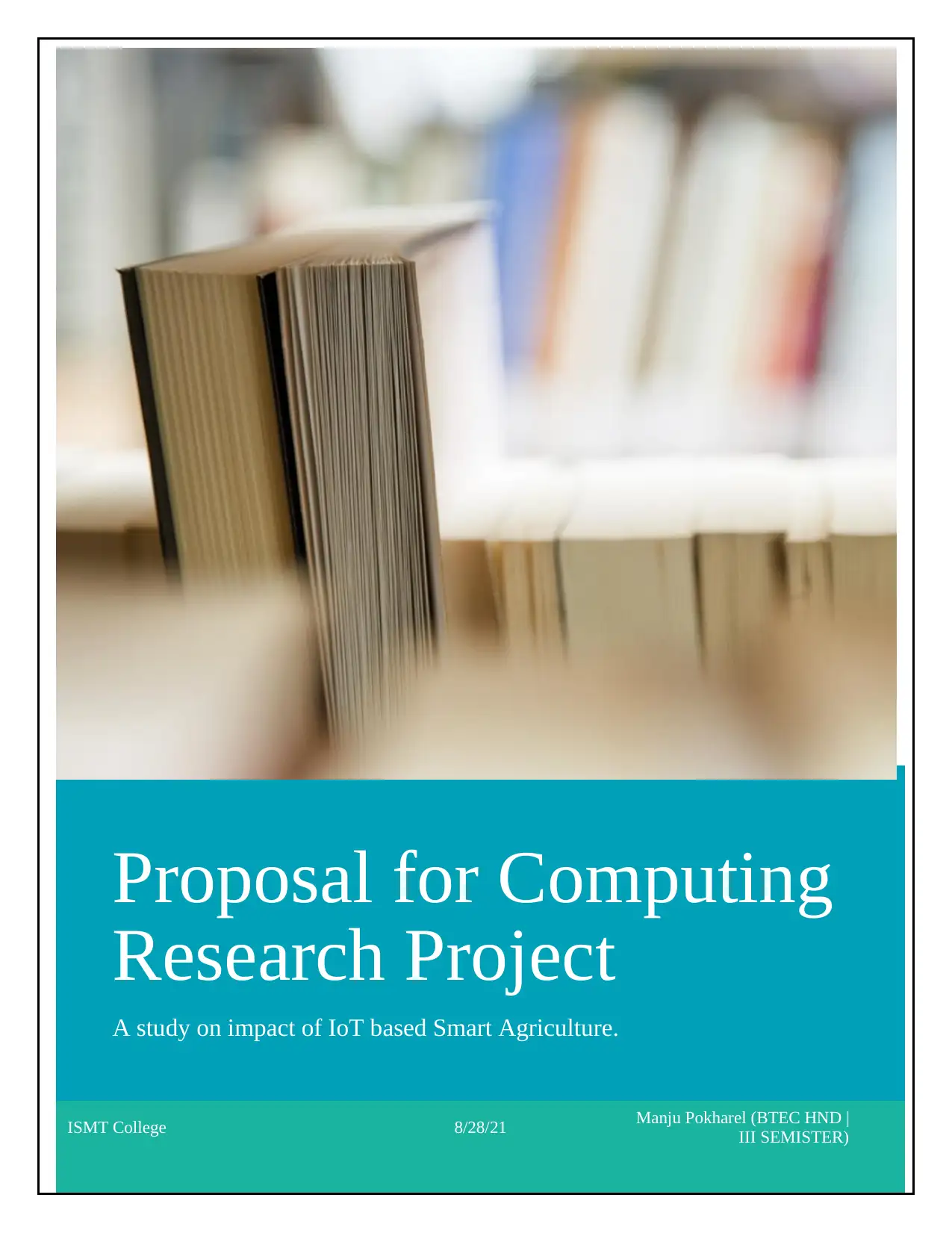
Proposal for Computing Research Project | ISMT College
[TYPE HERE] [TYPE HERE] 0 | P A G E
Proposal for Computing
Research Project
A study on impact of IoT based Smart Agriculture.
ISMT College 8/28/21 Manju Pokharel (BTEC HND |
III SEMISTER)
[TYPE HERE] [TYPE HERE] 0 | P A G E
Proposal for Computing
Research Project
A study on impact of IoT based Smart Agriculture.
ISMT College 8/28/21 Manju Pokharel (BTEC HND |
III SEMISTER)
Paraphrase This Document
Need a fresh take? Get an instant paraphrase of this document with our AI Paraphraser

Proposal for Computing Research Project | ISMT College
MANJU POKHAREL (BTEC HND | III SEMISTER)
Table of Contents
Chapter 1: Introduction ................................................................................................................... 1
1.1 Background Study ................................................................................................................. 1
1.2 Problem Statement ................................................................................................................ 2
1.3 Research Questions: .............................................................................................................. 4
1.4 Significance of the study ....................................................................................................... 4
1.5 Scope and limitation of the research: .................................................................................... 5
1.6 Research Objectives: ............................................................................................................. 6
Chapter 2: Reasons for choosing the topic ...................................................................................... 6
Chapter 3: Literature Review .......................................................................................................... 7
Chapter 4: Methodology .................................................................................................................. 9
3.1 Research Methodology: ......................................................................................................... 9
3.2 Data Collection: ................................................................................................................... 12
3.3 Population and Sample: ....................................................................................................... 13
Chapter 4: Time Schedule ............................................................................................................. 13
Chapter 5: Conclusion .................................................................................................................. 16
References ..................................................................................................................................... 16
MANJU POKHAREL (BTEC HND | III SEMISTER)
Table of Contents
Chapter 1: Introduction ................................................................................................................... 1
1.1 Background Study ................................................................................................................. 1
1.2 Problem Statement ................................................................................................................ 2
1.3 Research Questions: .............................................................................................................. 4
1.4 Significance of the study ....................................................................................................... 4
1.5 Scope and limitation of the research: .................................................................................... 5
1.6 Research Objectives: ............................................................................................................. 6
Chapter 2: Reasons for choosing the topic ...................................................................................... 6
Chapter 3: Literature Review .......................................................................................................... 7
Chapter 4: Methodology .................................................................................................................. 9
3.1 Research Methodology: ......................................................................................................... 9
3.2 Data Collection: ................................................................................................................... 12
3.3 Population and Sample: ....................................................................................................... 13
Chapter 4: Time Schedule ............................................................................................................. 13
Chapter 5: Conclusion .................................................................................................................. 16
References ..................................................................................................................................... 16
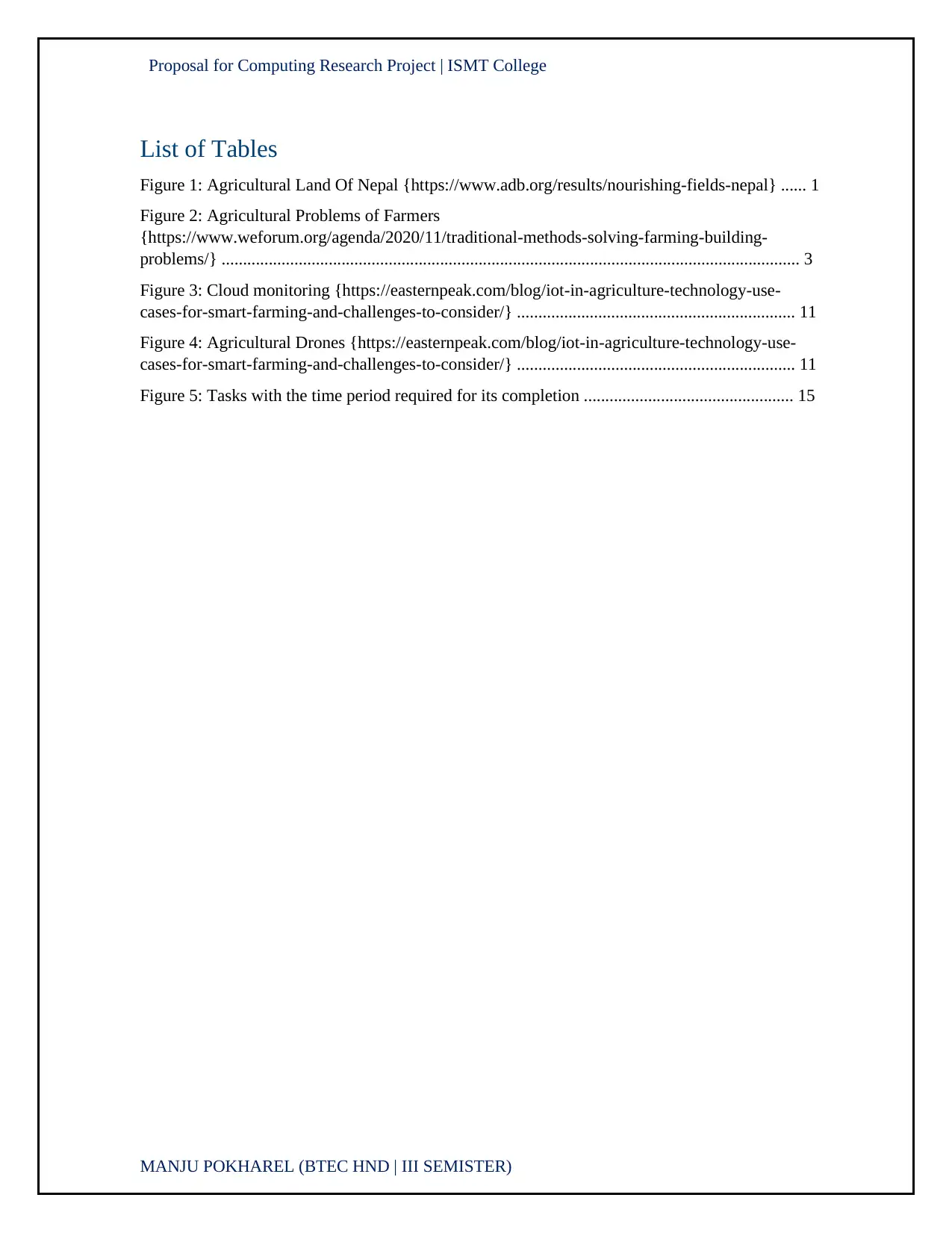
Proposal for Computing Research Project | ISMT College
MANJU POKHAREL (BTEC HND | III SEMISTER)
List of Tables
Figure 1: Agricultural Land Of Nepal {https://www.adb.org/results/nourishing-fields-nepal} ...... 1
Figure 2: Agricultural Problems of Farmers
{https://www.weforum.org/agenda/2020/11/traditional-methods-solving-farming-building-
problems/} ....................................................................................................................................... 3
Figure 3: Cloud monitoring {https://easternpeak.com/blog/iot-in-agriculture-technology-use-
cases-for-smart-farming-and-challenges-to-consider/} ................................................................. 11
Figure 4: Agricultural Drones {https://easternpeak.com/blog/iot-in-agriculture-technology-use-
cases-for-smart-farming-and-challenges-to-consider/} ................................................................. 11
Figure 5: Tasks with the time period required for its completion ................................................. 15
MANJU POKHAREL (BTEC HND | III SEMISTER)
List of Tables
Figure 1: Agricultural Land Of Nepal {https://www.adb.org/results/nourishing-fields-nepal} ...... 1
Figure 2: Agricultural Problems of Farmers
{https://www.weforum.org/agenda/2020/11/traditional-methods-solving-farming-building-
problems/} ....................................................................................................................................... 3
Figure 3: Cloud monitoring {https://easternpeak.com/blog/iot-in-agriculture-technology-use-
cases-for-smart-farming-and-challenges-to-consider/} ................................................................. 11
Figure 4: Agricultural Drones {https://easternpeak.com/blog/iot-in-agriculture-technology-use-
cases-for-smart-farming-and-challenges-to-consider/} ................................................................. 11
Figure 5: Tasks with the time period required for its completion ................................................. 15
⊘ This is a preview!⊘
Do you want full access?
Subscribe today to unlock all pages.

Trusted by 1+ million students worldwide

Proposal for Computing Research Project | ISMT College
MANJU POKHAREL (BTEC HND | III SEMISTER) 1 | P a g e
Chapter 1: Introduction
1.1 Background Study
The internet of things or simply IoT is a system of interrelated computing devices, mechanical
and digital machines, objects, animals or people that are provided with unique identifiers and the
ability to transfer data over a network without requiring human-to-human or human-to-computer
interaction. It is a system of physical objects whose purpose is to collect and exchange data with
each other over the Internet. The invention and involvement of IoT revolutionized has different
processes that are involved in many domains such as home security, equipment manufacturing,
health monitoring, automated transportation and especially agriculture. In modern agriculture,
IoT is efficiently utilized in many subdomains such as precision farming, smart crop monitoring,
soil quality, smart irrigation systems and mainly others.
Figure 1: Agricultural Land Of Nepal {https://www.adb.org/results/nourishing-fields-nepal}
Agriculture is an important part of Nepal's economy and is the backbone of our country. Around
68% of livelihood is depended on agriculture which accounts for about 34% of the Gross
Domestic Product (GDP). Like Nepal and other countries, majority of country population
depends on farming and nations incomes has comes from farming. Agriculture is major boon to
country's economy. Agriculture contributes nearly one-third of the nation's GDP and provides
MANJU POKHAREL (BTEC HND | III SEMISTER) 1 | P a g e
Chapter 1: Introduction
1.1 Background Study
The internet of things or simply IoT is a system of interrelated computing devices, mechanical
and digital machines, objects, animals or people that are provided with unique identifiers and the
ability to transfer data over a network without requiring human-to-human or human-to-computer
interaction. It is a system of physical objects whose purpose is to collect and exchange data with
each other over the Internet. The invention and involvement of IoT revolutionized has different
processes that are involved in many domains such as home security, equipment manufacturing,
health monitoring, automated transportation and especially agriculture. In modern agriculture,
IoT is efficiently utilized in many subdomains such as precision farming, smart crop monitoring,
soil quality, smart irrigation systems and mainly others.
Figure 1: Agricultural Land Of Nepal {https://www.adb.org/results/nourishing-fields-nepal}
Agriculture is an important part of Nepal's economy and is the backbone of our country. Around
68% of livelihood is depended on agriculture which accounts for about 34% of the Gross
Domestic Product (GDP). Like Nepal and other countries, majority of country population
depends on farming and nations incomes has comes from farming. Agriculture is major boon to
country's economy. Agriculture contributes nearly one-third of the nation's GDP and provides
Paraphrase This Document
Need a fresh take? Get an instant paraphrase of this document with our AI Paraphraser

Proposal for Computing Research Project | ISMT College
MANJU POKHAREL (BTEC HND | III SEMISTER) 2 | P A G E
employment to two-third of the Nepali people. However, the annual population growth rate of
1.3% has put pressure on agricultural productivity and one of its impacts seen is the decreasing
value added by agriculture in GDP. The agro-ecological lands of Nepal have been divided into
three kinds: the terai, or the plains, the hills in the midsection, and the mountainous region. 23%
of the land area lies in Terai part of Nepal and is the most fertile land. The annual cultivation rate
in terai region is over 40%.Terai region produces crops including jute, sugarcane, maize, wheat,
and vegetables. The hilly region comprises of 42% of the land area of Nepal, but only 20% of it
is currently used for cultivation. Maize and wheat are mostly produced here. Owing to weather
conditions, only 5% of the land in mountainous region is suitable for cultivation. Out of the
country’s 14.7-billion-hectare area, only 2.6 million hectares of land in Nepal is arable. With the
increasing population, the per capita consumption demand for agricultural products is expected to
grow rapidly. For example, the demand for fresh vegetables is expected to grow at 1.9% annually
till 2020. It is therefore, more important now than ever to utilize these arable land to produce
maximum crops possible.
The main purpose of this study will be investing how IoT based smart agriculture change the face
of farming and cultivation. Now a day, Farmers can get lots of knowledge and information about
latest technology and farming techniques through IoT. In smart farming, a system is built for
monitoring the crop field with the help of sensors (i.e. light, humidity, temperature, soil moisture
etc.) and automating the irrigation system.
1.2 Problem Statement
The traditional agriculture and allied sector cannot meet the requirements of modern and smart
agriculture which requires high-yield, high quality and efficient output. Similarly, the major
problems that farmers face is irregular distribution of water in the field. Crops don't get the
required nutrients because of poor soil quality which results in the improper growth of crops.
Agricultural tools are not advanced. Due to traditional farming, cultivation is very difficult and
production is low. Farmers are not skilled in the methods of the modern agriculture. They are also
not healthy enough to realize the potential of their farms. Similarly, due to lack of market agro-
MANJU POKHAREL (BTEC HND | III SEMISTER) 2 | P A G E
employment to two-third of the Nepali people. However, the annual population growth rate of
1.3% has put pressure on agricultural productivity and one of its impacts seen is the decreasing
value added by agriculture in GDP. The agro-ecological lands of Nepal have been divided into
three kinds: the terai, or the plains, the hills in the midsection, and the mountainous region. 23%
of the land area lies in Terai part of Nepal and is the most fertile land. The annual cultivation rate
in terai region is over 40%.Terai region produces crops including jute, sugarcane, maize, wheat,
and vegetables. The hilly region comprises of 42% of the land area of Nepal, but only 20% of it
is currently used for cultivation. Maize and wheat are mostly produced here. Owing to weather
conditions, only 5% of the land in mountainous region is suitable for cultivation. Out of the
country’s 14.7-billion-hectare area, only 2.6 million hectares of land in Nepal is arable. With the
increasing population, the per capita consumption demand for agricultural products is expected to
grow rapidly. For example, the demand for fresh vegetables is expected to grow at 1.9% annually
till 2020. It is therefore, more important now than ever to utilize these arable land to produce
maximum crops possible.
The main purpose of this study will be investing how IoT based smart agriculture change the face
of farming and cultivation. Now a day, Farmers can get lots of knowledge and information about
latest technology and farming techniques through IoT. In smart farming, a system is built for
monitoring the crop field with the help of sensors (i.e. light, humidity, temperature, soil moisture
etc.) and automating the irrigation system.
1.2 Problem Statement
The traditional agriculture and allied sector cannot meet the requirements of modern and smart
agriculture which requires high-yield, high quality and efficient output. Similarly, the major
problems that farmers face is irregular distribution of water in the field. Crops don't get the
required nutrients because of poor soil quality which results in the improper growth of crops.
Agricultural tools are not advanced. Due to traditional farming, cultivation is very difficult and
production is low. Farmers are not skilled in the methods of the modern agriculture. They are also
not healthy enough to realize the potential of their farms. Similarly, due to lack of market agro-

Proposal for Computing Research Project | ISMT College
MANJU POKHAREL (BTEC HND | III SEMISTER) 3 | P A G E
based products rot in the places where they are grown. Food grains that are grown in terai cannot
be transported to other areas nor easily can fruits such as apple grown in the north easily get
market in the south. Due to lack of storage facilities, agricultural products suffer low price. Fertile
valley and plains are being occupied by the settlement and industries land distribution is not
scientific and democratic. These are day to day problems faced by farmers of Nepal.
Figure 2: Agricultural Problems of Farmers
{https://www.weforum.org/agenda/2020/11/traditional-methods-solving-farming-building-
problems/}
Thus, as a solution to the existing problems, I have focused on smart Agricultures and farming
automated system with the help of IoT. I have focused on smart systems for monitoring and
controlling agricultural parameters by enhancing productivity and efficiency. Smart systems
collect data for measurements to get accurate results that can lead to accurate actions. Current use
of smart agricultural system relates to collecting data on environment parameters such as
temperature, humidity, soil moisture. With accurate sensor data collection using a range of
different sensors, I will implement smart agricultural systems to make the farm process more
effective. I will mainly focus on sub-verticles such as water management, crop management,
smart farming, precision farming, smart greenhouse, agricultural drones and data analytics to
make processes automated by reducing human intervention costs, power consumption and water
consumption.
MANJU POKHAREL (BTEC HND | III SEMISTER) 3 | P A G E
based products rot in the places where they are grown. Food grains that are grown in terai cannot
be transported to other areas nor easily can fruits such as apple grown in the north easily get
market in the south. Due to lack of storage facilities, agricultural products suffer low price. Fertile
valley and plains are being occupied by the settlement and industries land distribution is not
scientific and democratic. These are day to day problems faced by farmers of Nepal.
Figure 2: Agricultural Problems of Farmers
{https://www.weforum.org/agenda/2020/11/traditional-methods-solving-farming-building-
problems/}
Thus, as a solution to the existing problems, I have focused on smart Agricultures and farming
automated system with the help of IoT. I have focused on smart systems for monitoring and
controlling agricultural parameters by enhancing productivity and efficiency. Smart systems
collect data for measurements to get accurate results that can lead to accurate actions. Current use
of smart agricultural system relates to collecting data on environment parameters such as
temperature, humidity, soil moisture. With accurate sensor data collection using a range of
different sensors, I will implement smart agricultural systems to make the farm process more
effective. I will mainly focus on sub-verticles such as water management, crop management,
smart farming, precision farming, smart greenhouse, agricultural drones and data analytics to
make processes automated by reducing human intervention costs, power consumption and water
consumption.
⊘ This is a preview!⊘
Do you want full access?
Subscribe today to unlock all pages.

Trusted by 1+ million students worldwide
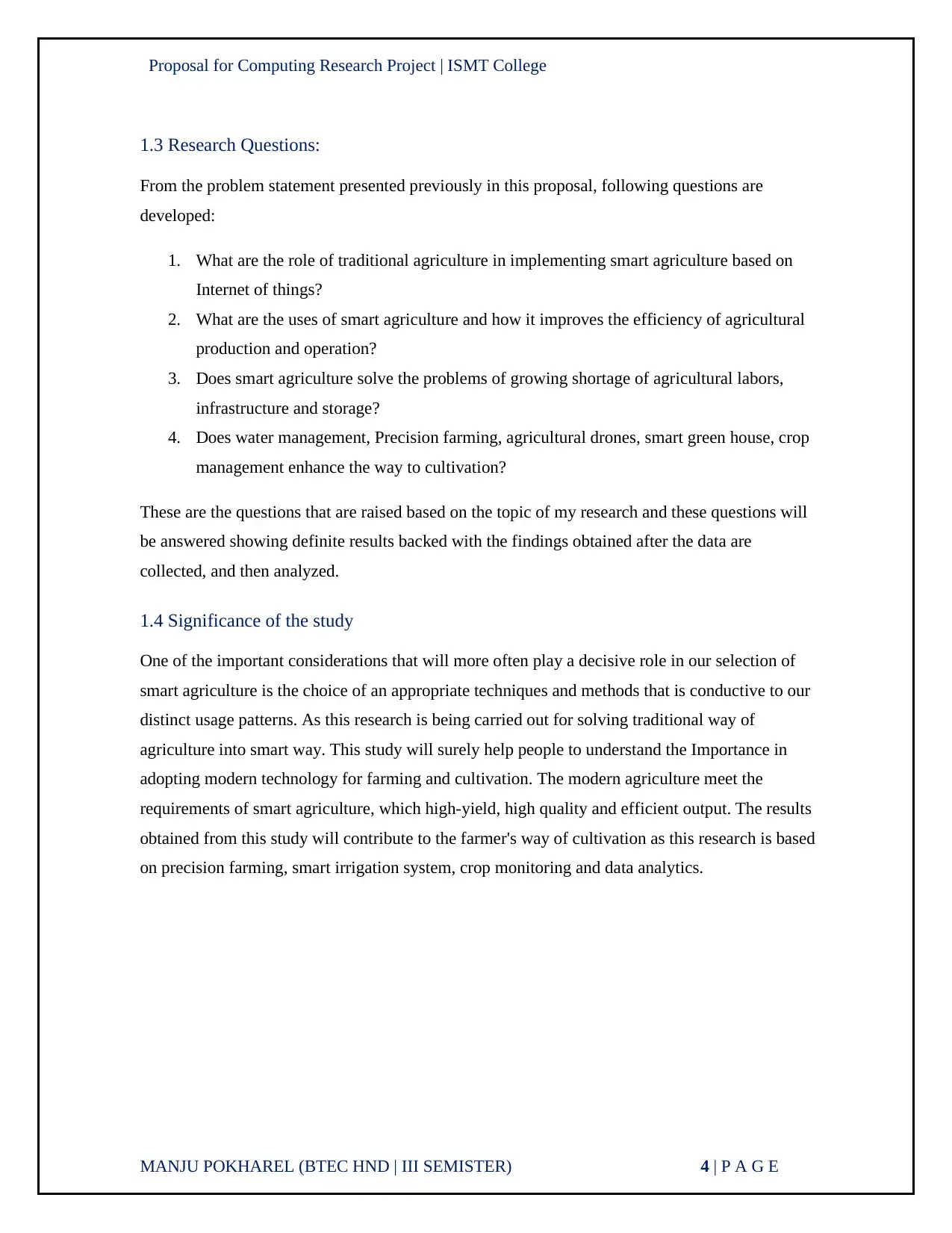
Proposal for Computing Research Project | ISMT College
MANJU POKHAREL (BTEC HND | III SEMISTER) 4 | P A G E
1.3 Research Questions:
From the problem statement presented previously in this proposal, following questions are
developed:
1. What are the role of traditional agriculture in implementing smart agriculture based on
Internet of things?
2. What are the uses of smart agriculture and how it improves the efficiency of agricultural
production and operation?
3. Does smart agriculture solve the problems of growing shortage of agricultural labors,
infrastructure and storage?
4. Does water management, Precision farming, agricultural drones, smart green house, crop
management enhance the way to cultivation?
These are the questions that are raised based on the topic of my research and these questions will
be answered showing definite results backed with the findings obtained after the data are
collected, and then analyzed.
1.4 Significance of the study
One of the important considerations that will more often play a decisive role in our selection of
smart agriculture is the choice of an appropriate techniques and methods that is conductive to our
distinct usage patterns. As this research is being carried out for solving traditional way of
agriculture into smart way. This study will surely help people to understand the Importance in
adopting modern technology for farming and cultivation. The modern agriculture meet the
requirements of smart agriculture, which high-yield, high quality and efficient output. The results
obtained from this study will contribute to the farmer's way of cultivation as this research is based
on precision farming, smart irrigation system, crop monitoring and data analytics.
MANJU POKHAREL (BTEC HND | III SEMISTER) 4 | P A G E
1.3 Research Questions:
From the problem statement presented previously in this proposal, following questions are
developed:
1. What are the role of traditional agriculture in implementing smart agriculture based on
Internet of things?
2. What are the uses of smart agriculture and how it improves the efficiency of agricultural
production and operation?
3. Does smart agriculture solve the problems of growing shortage of agricultural labors,
infrastructure and storage?
4. Does water management, Precision farming, agricultural drones, smart green house, crop
management enhance the way to cultivation?
These are the questions that are raised based on the topic of my research and these questions will
be answered showing definite results backed with the findings obtained after the data are
collected, and then analyzed.
1.4 Significance of the study
One of the important considerations that will more often play a decisive role in our selection of
smart agriculture is the choice of an appropriate techniques and methods that is conductive to our
distinct usage patterns. As this research is being carried out for solving traditional way of
agriculture into smart way. This study will surely help people to understand the Importance in
adopting modern technology for farming and cultivation. The modern agriculture meet the
requirements of smart agriculture, which high-yield, high quality and efficient output. The results
obtained from this study will contribute to the farmer's way of cultivation as this research is based
on precision farming, smart irrigation system, crop monitoring and data analytics.
Paraphrase This Document
Need a fresh take? Get an instant paraphrase of this document with our AI Paraphraser

Proposal for Computing Research Project | ISMT College
MANJU POKHAREL (BTEC HND | III SEMISTER) 5 | P A G E
1.5 Scope and limitation of the research:
Smart farming based on IoT technologies enables growers and farmers to reduce waste and
enhance productivity and enabling efficient utilization of resources such as water etc. Agricultural
Drones used in agriculture enhance various agriculture practices, crop health, irrigation, data and
field analysis. Data collected by smart agriculture sensors can be used to track the state of the
business in general as well as staff performance, equipment efficiency. Similarly, smart
greenhouse intelligently controls the climate, eliminating the need for manual intervention.
Precision farming makes the farming practice more precise and controlled by realizing smart
farming applications such as livestock monitoring, Field observation and inventory monitoring.
These all methods and techniques directly changes the face of traditional agriculture.
Implementing this methods will rapidly enhance the future of agriculture.
Smart devices based on IoT must have unique identities and they should have the ability to
connect and interact with each other and with other network entities along with mobile and web-
based platforms. IoT devices enables farm managers to track crops in real-time, with precise
planting, water management and smart greenhouse management etc. Unfortunately, there is too
high rate of water turnover from the agricultural sector to other industries. Unlike other industries,
IoT system devices installations and maintenance are a little troublesome and need lot of
investment, smart farming continually requires internet connectivity. But rural portion of our
country did not follow those criteria and the internet is slower. The IoT related equipment allows
the farmers to understand the use of technology and to learn. It is the biggest challenge for
Nepalese farmers as one third of Nepalese farmers are uneducated and are not aware of these
modern technology.
This research considers the respondents of the age group 45-60 years old and else with these
people engaged in farming. This research will be organized in a short period of time (about 5
months) in a particular location where the respondents are provided with a set of questionnaires
and different interviewing question will be asked to perform descriptive analysis of certain
criteria which cannot be measured in quantity but rather in a qualitative manner. Due to limited
MANJU POKHAREL (BTEC HND | III SEMISTER) 5 | P A G E
1.5 Scope and limitation of the research:
Smart farming based on IoT technologies enables growers and farmers to reduce waste and
enhance productivity and enabling efficient utilization of resources such as water etc. Agricultural
Drones used in agriculture enhance various agriculture practices, crop health, irrigation, data and
field analysis. Data collected by smart agriculture sensors can be used to track the state of the
business in general as well as staff performance, equipment efficiency. Similarly, smart
greenhouse intelligently controls the climate, eliminating the need for manual intervention.
Precision farming makes the farming practice more precise and controlled by realizing smart
farming applications such as livestock monitoring, Field observation and inventory monitoring.
These all methods and techniques directly changes the face of traditional agriculture.
Implementing this methods will rapidly enhance the future of agriculture.
Smart devices based on IoT must have unique identities and they should have the ability to
connect and interact with each other and with other network entities along with mobile and web-
based platforms. IoT devices enables farm managers to track crops in real-time, with precise
planting, water management and smart greenhouse management etc. Unfortunately, there is too
high rate of water turnover from the agricultural sector to other industries. Unlike other industries,
IoT system devices installations and maintenance are a little troublesome and need lot of
investment, smart farming continually requires internet connectivity. But rural portion of our
country did not follow those criteria and the internet is slower. The IoT related equipment allows
the farmers to understand the use of technology and to learn. It is the biggest challenge for
Nepalese farmers as one third of Nepalese farmers are uneducated and are not aware of these
modern technology.
This research considers the respondents of the age group 45-60 years old and else with these
people engaged in farming. This research will be organized in a short period of time (about 5
months) in a particular location where the respondents are provided with a set of questionnaires
and different interviewing question will be asked to perform descriptive analysis of certain
criteria which cannot be measured in quantity but rather in a qualitative manner. Due to limited
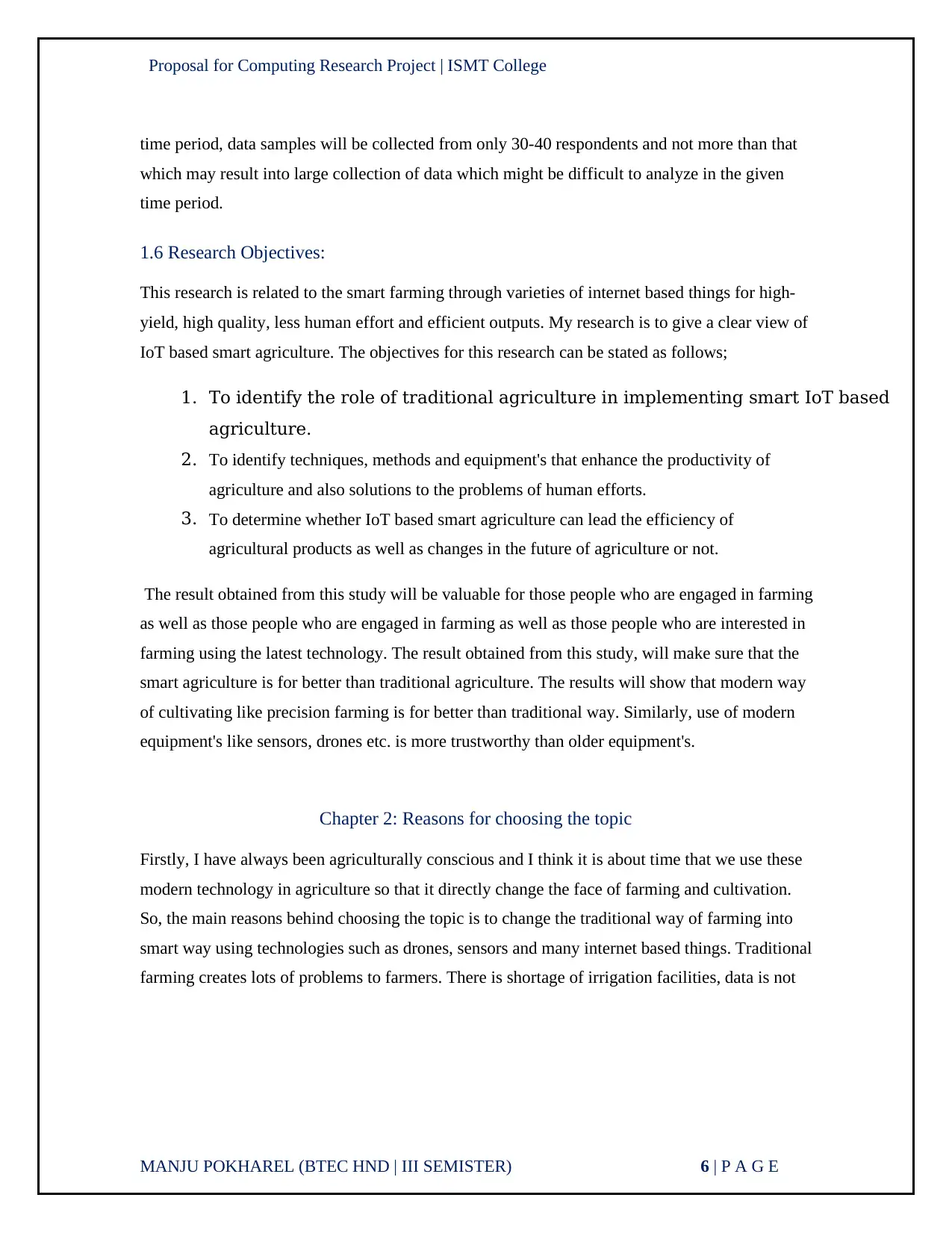
Proposal for Computing Research Project | ISMT College
MANJU POKHAREL (BTEC HND | III SEMISTER) 6 | P A G E
time period, data samples will be collected from only 30-40 respondents and not more than that
which may result into large collection of data which might be difficult to analyze in the given
time period.
1.6 Research Objectives:
This research is related to the smart farming through varieties of internet based things for high-
yield, high quality, less human effort and efficient outputs. My research is to give a clear view of
IoT based smart agriculture. The objectives for this research can be stated as follows;
1. To identify the role of traditional agriculture in implementing smart IoT based
agriculture.
2. To identify techniques, methods and equipment's that enhance the productivity of
agriculture and also solutions to the problems of human efforts.
3. To determine whether IoT based smart agriculture can lead the efficiency of
agricultural products as well as changes in the future of agriculture or not.
The result obtained from this study will be valuable for those people who are engaged in farming
as well as those people who are engaged in farming as well as those people who are interested in
farming using the latest technology. The result obtained from this study, will make sure that the
smart agriculture is for better than traditional agriculture. The results will show that modern way
of cultivating like precision farming is for better than traditional way. Similarly, use of modern
equipment's like sensors, drones etc. is more trustworthy than older equipment's.
Chapter 2: Reasons for choosing the topic
Firstly, I have always been agriculturally conscious and I think it is about time that we use these
modern technology in agriculture so that it directly change the face of farming and cultivation.
So, the main reasons behind choosing the topic is to change the traditional way of farming into
smart way using technologies such as drones, sensors and many internet based things. Traditional
farming creates lots of problems to farmers. There is shortage of irrigation facilities, data is not
MANJU POKHAREL (BTEC HND | III SEMISTER) 6 | P A G E
time period, data samples will be collected from only 30-40 respondents and not more than that
which may result into large collection of data which might be difficult to analyze in the given
time period.
1.6 Research Objectives:
This research is related to the smart farming through varieties of internet based things for high-
yield, high quality, less human effort and efficient outputs. My research is to give a clear view of
IoT based smart agriculture. The objectives for this research can be stated as follows;
1. To identify the role of traditional agriculture in implementing smart IoT based
agriculture.
2. To identify techniques, methods and equipment's that enhance the productivity of
agriculture and also solutions to the problems of human efforts.
3. To determine whether IoT based smart agriculture can lead the efficiency of
agricultural products as well as changes in the future of agriculture or not.
The result obtained from this study will be valuable for those people who are engaged in farming
as well as those people who are engaged in farming as well as those people who are interested in
farming using the latest technology. The result obtained from this study, will make sure that the
smart agriculture is for better than traditional agriculture. The results will show that modern way
of cultivating like precision farming is for better than traditional way. Similarly, use of modern
equipment's like sensors, drones etc. is more trustworthy than older equipment's.
Chapter 2: Reasons for choosing the topic
Firstly, I have always been agriculturally conscious and I think it is about time that we use these
modern technology in agriculture so that it directly change the face of farming and cultivation.
So, the main reasons behind choosing the topic is to change the traditional way of farming into
smart way using technologies such as drones, sensors and many internet based things. Traditional
farming creates lots of problems to farmers. There is shortage of irrigation facilities, data is not
⊘ This is a preview!⊘
Do you want full access?
Subscribe today to unlock all pages.

Trusted by 1+ million students worldwide
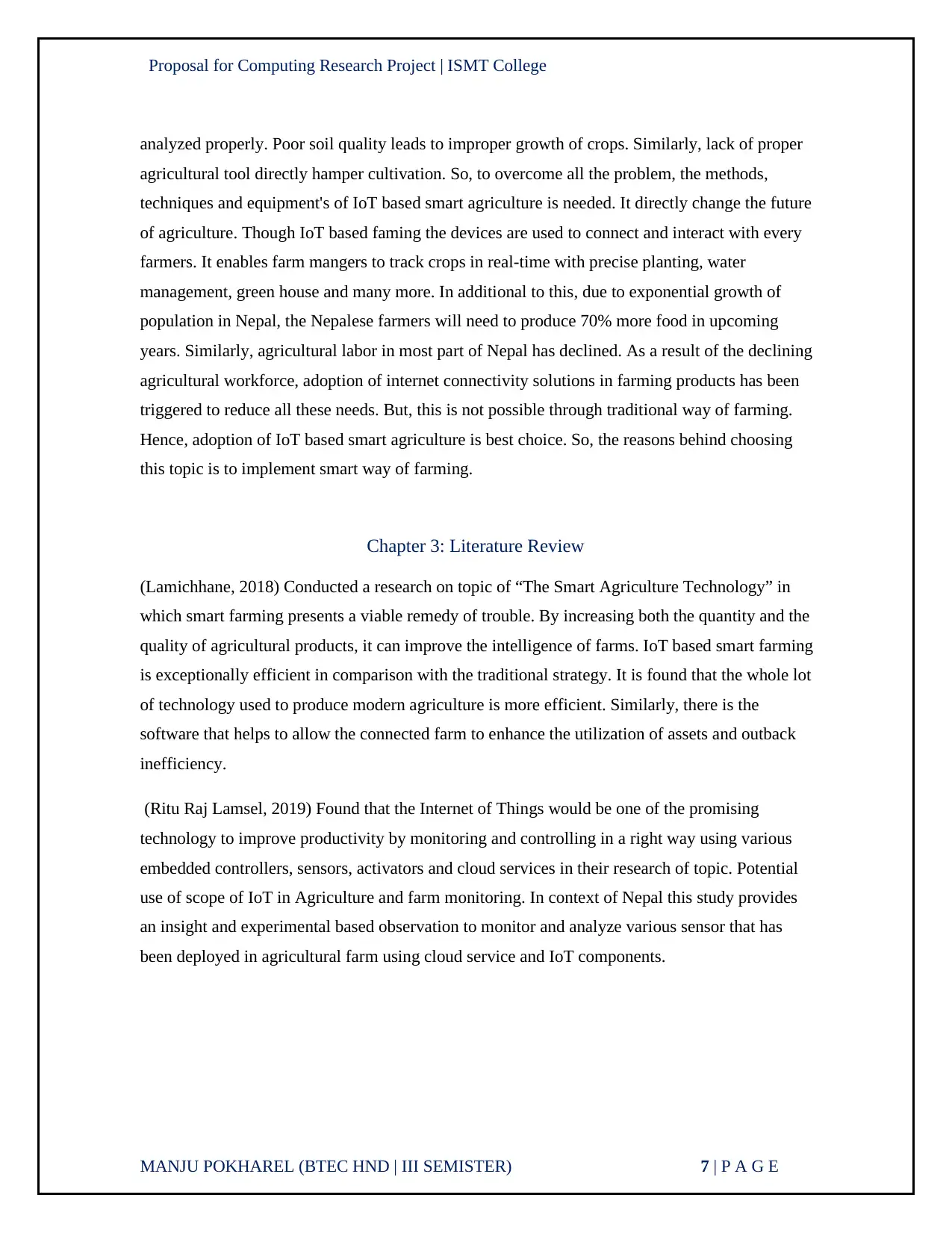
Proposal for Computing Research Project | ISMT College
MANJU POKHAREL (BTEC HND | III SEMISTER) 7 | P A G E
analyzed properly. Poor soil quality leads to improper growth of crops. Similarly, lack of proper
agricultural tool directly hamper cultivation. So, to overcome all the problem, the methods,
techniques and equipment's of IoT based smart agriculture is needed. It directly change the future
of agriculture. Though IoT based faming the devices are used to connect and interact with every
farmers. It enables farm mangers to track crops in real-time with precise planting, water
management, green house and many more. In additional to this, due to exponential growth of
population in Nepal, the Nepalese farmers will need to produce 70% more food in upcoming
years. Similarly, agricultural labor in most part of Nepal has declined. As a result of the declining
agricultural workforce, adoption of internet connectivity solutions in farming products has been
triggered to reduce all these needs. But, this is not possible through traditional way of farming.
Hence, adoption of IoT based smart agriculture is best choice. So, the reasons behind choosing
this topic is to implement smart way of farming.
Chapter 3: Literature Review
(Lamichhane, 2018) Conducted a research on topic of “The Smart Agriculture Technology” in
which smart farming presents a viable remedy of trouble. By increasing both the quantity and the
quality of agricultural products, it can improve the intelligence of farms. IoT based smart farming
is exceptionally efficient in comparison with the traditional strategy. It is found that the whole lot
of technology used to produce modern agriculture is more efficient. Similarly, there is the
software that helps to allow the connected farm to enhance the utilization of assets and outback
inefficiency.
(Ritu Raj Lamsel, 2019) Found that the Internet of Things would be one of the promising
technology to improve productivity by monitoring and controlling in a right way using various
embedded controllers, sensors, activators and cloud services in their research of topic. Potential
use of scope of IoT in Agriculture and farm monitoring. In context of Nepal this study provides
an insight and experimental based observation to monitor and analyze various sensor that has
been deployed in agricultural farm using cloud service and IoT components.
MANJU POKHAREL (BTEC HND | III SEMISTER) 7 | P A G E
analyzed properly. Poor soil quality leads to improper growth of crops. Similarly, lack of proper
agricultural tool directly hamper cultivation. So, to overcome all the problem, the methods,
techniques and equipment's of IoT based smart agriculture is needed. It directly change the future
of agriculture. Though IoT based faming the devices are used to connect and interact with every
farmers. It enables farm mangers to track crops in real-time with precise planting, water
management, green house and many more. In additional to this, due to exponential growth of
population in Nepal, the Nepalese farmers will need to produce 70% more food in upcoming
years. Similarly, agricultural labor in most part of Nepal has declined. As a result of the declining
agricultural workforce, adoption of internet connectivity solutions in farming products has been
triggered to reduce all these needs. But, this is not possible through traditional way of farming.
Hence, adoption of IoT based smart agriculture is best choice. So, the reasons behind choosing
this topic is to implement smart way of farming.
Chapter 3: Literature Review
(Lamichhane, 2018) Conducted a research on topic of “The Smart Agriculture Technology” in
which smart farming presents a viable remedy of trouble. By increasing both the quantity and the
quality of agricultural products, it can improve the intelligence of farms. IoT based smart farming
is exceptionally efficient in comparison with the traditional strategy. It is found that the whole lot
of technology used to produce modern agriculture is more efficient. Similarly, there is the
software that helps to allow the connected farm to enhance the utilization of assets and outback
inefficiency.
(Ritu Raj Lamsel, 2019) Found that the Internet of Things would be one of the promising
technology to improve productivity by monitoring and controlling in a right way using various
embedded controllers, sensors, activators and cloud services in their research of topic. Potential
use of scope of IoT in Agriculture and farm monitoring. In context of Nepal this study provides
an insight and experimental based observation to monitor and analyze various sensor that has
been deployed in agricultural farm using cloud service and IoT components.
Paraphrase This Document
Need a fresh take? Get an instant paraphrase of this document with our AI Paraphraser

Proposal for Computing Research Project | ISMT College
MANJU POKHAREL (BTEC HND | III SEMISTER) 8 | P A G E
As from one of the journals of Nepal, (Rajan Bhandari)three people, Rajan Bhandari, Ravi and
Nirdesh Bhami together form a company which plans to automate a widely used cooling storage
systems. They introduce “zero cooling technology” that basically use locally available resources
like bamboos, bricks and water to create a chamber where the temperature is lower than the room
temperature which is to be maintained manually. They come up with a technology that would
detect the humidity, moisture and all the other factors that are needed to have the constant
temperature for proper storage of fruit and vegetable.
MANJU POKHAREL (BTEC HND | III SEMISTER) 8 | P A G E
As from one of the journals of Nepal, (Rajan Bhandari)three people, Rajan Bhandari, Ravi and
Nirdesh Bhami together form a company which plans to automate a widely used cooling storage
systems. They introduce “zero cooling technology” that basically use locally available resources
like bamboos, bricks and water to create a chamber where the temperature is lower than the room
temperature which is to be maintained manually. They come up with a technology that would
detect the humidity, moisture and all the other factors that are needed to have the constant
temperature for proper storage of fruit and vegetable.
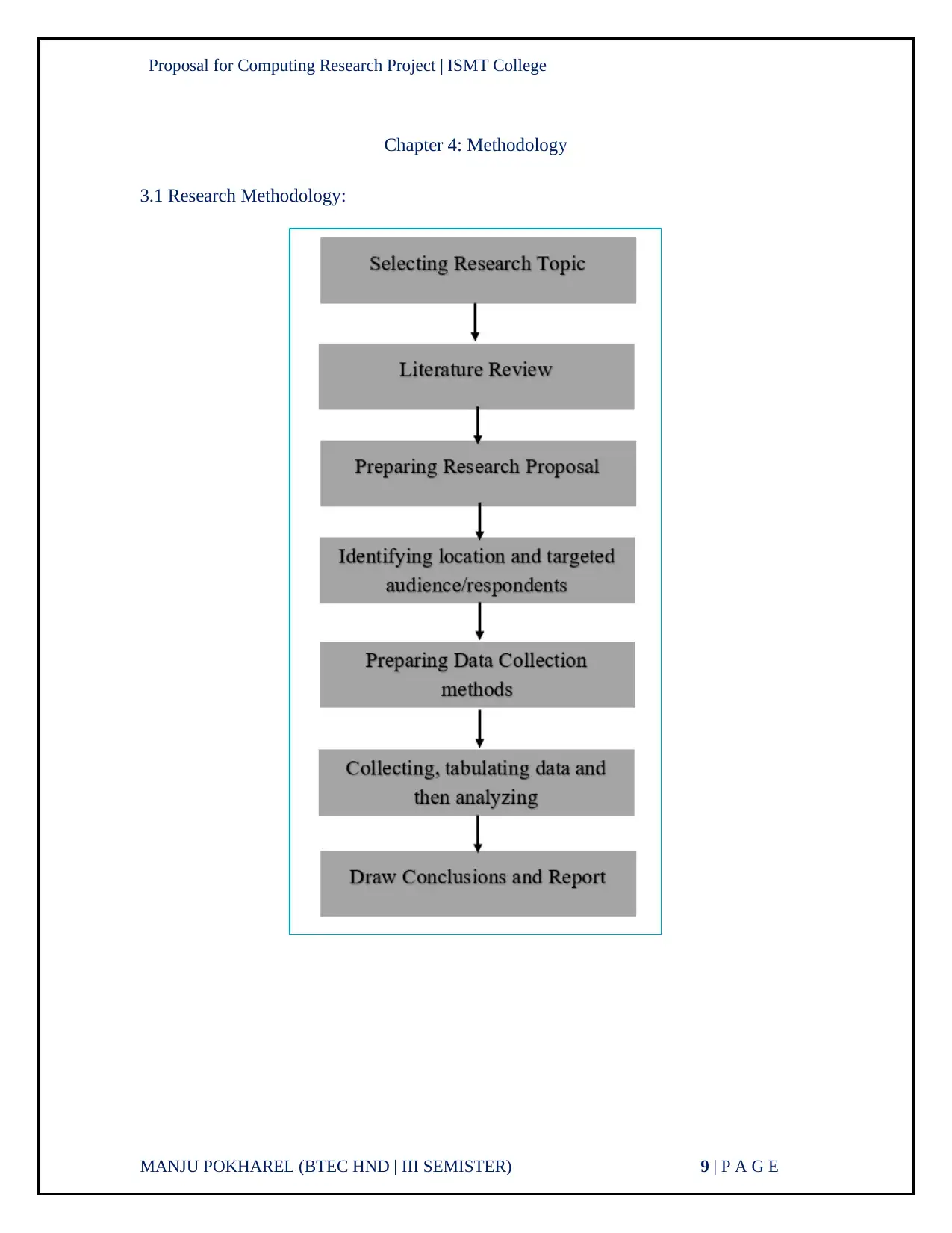
Proposal for Computing Research Project | ISMT College
MANJU POKHAREL (BTEC HND | III SEMISTER) 9 | P A G E
Chapter 4: Methodology
3.1 Research Methodology:
MANJU POKHAREL (BTEC HND | III SEMISTER) 9 | P A G E
Chapter 4: Methodology
3.1 Research Methodology:
⊘ This is a preview!⊘
Do you want full access?
Subscribe today to unlock all pages.

Trusted by 1+ million students worldwide
1 out of 21
Your All-in-One AI-Powered Toolkit for Academic Success.
+13062052269
info@desklib.com
Available 24*7 on WhatsApp / Email
![[object Object]](/_next/static/media/star-bottom.7253800d.svg)
Unlock your academic potential
Copyright © 2020–2025 A2Z Services. All Rights Reserved. Developed and managed by ZUCOL.